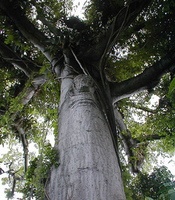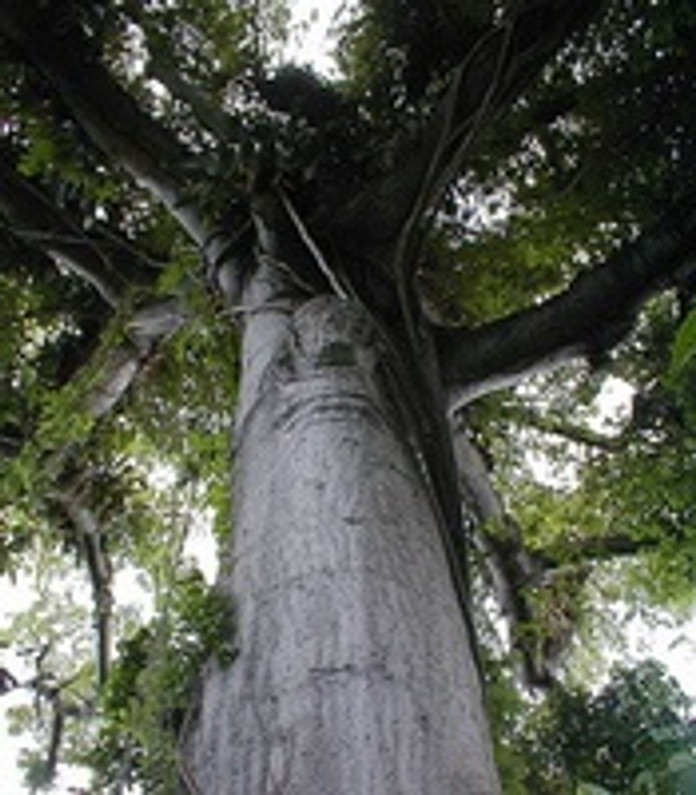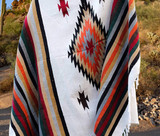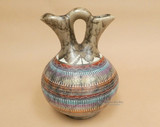The Tree Of Life - Wall Hangings & Tapestries
 The tree of life is a symbol seen in hand weaving tradition that has had special meaning in Native American life as well as many other cultures throughout history. The Tree of life is usually depicted more as a vine or tree growing in a straight line, however it has taken different forms in different areas. The common practice between cultures is to relate the symbolic tree of life design to an actual tree in the area. In order for a tree to attain this level of adoration it is usually a plant that is considered sacred to the local people because of its uses and benefits to the community. This tree was also thought to represent the axis of the world, rising from the earth to the heavens.
The tree of life is a symbol seen in hand weaving tradition that has had special meaning in Native American life as well as many other cultures throughout history. The Tree of life is usually depicted more as a vine or tree growing in a straight line, however it has taken different forms in different areas. The common practice between cultures is to relate the symbolic tree of life design to an actual tree in the area. In order for a tree to attain this level of adoration it is usually a plant that is considered sacred to the local people because of its uses and benefits to the community. This tree was also thought to represent the axis of the world, rising from the earth to the heavens.
Early, the Mayan Indians whose descendants are still in existence had a particularly interesting representation of the tree of life. In there civilization a tree existed that perfectly depicted the traditional concept. The Ceiba, was a very tall tree with few branches until the very top of the tree. This gave the tree the necessary earth’s axis feature but it also had something else very significant to the Mayans. As with most Native Americans and Indians of other cultures the four cardinal directions of north, south, east and west are honored in their spiritual and religious beliefs. The tree of life of the Mayans was unique in that it usually had four main branches at the top of the tree which corresponded to the four directions plus the truck representing up and down between heaven and earth.
This tree of life symbol became the center of their community life. It would also serve as the center of the village with its sense of balance and harmony between the natural and invisible forces of the universe. Its roots are grounded in the earth, representing natural or physical nutrition and its branches reaching skyward representing spiritual sustenance. The tree of life in Native tradition has also been found represented in southwestern cave drawings and rock art of the southwest. Many ancient tribes no longer exist such as the anasazi of what is present day Arizona. Some tribes in the region such as Navajo, Hopi, pueblo and Zuni do exist and continue their tribal traditions. Patterns and symbols have been handed down through the generations and though altered or stylized, the cultural traditions and stories continue. With the southwestern Indian tribes maize or corn was their main staple.
We see this to be true still today in the desert southwest and with the primitive Tarahumara Indians. Maize was the plant that centered their cultures like the Ceiba tree of the Mayans and became their particular representation of the tree of life symbol with its straight vertical stalk. Maize was the food staple and sustainer of life for these people, so naturally the plant was honored above others. In Native art such as painted pottery, woven rugs or Indian blankets, southwest designs use the corn plant. Often figures will be depicted holding ears of corn and a growing maize plant is depicted with ripe full ears in Native American art and southwest weavings. Now the woven designs can be more stylized, by using a long vertical line with short intersecting horizontal lines to represent the corn stalk and leaves. While patterns have changed over time, the symbols and meanings of the vertical and horizontal lines of Native weavings remain as a tribute to Indigenous values and the symbol of the tree of life.
See More Southwestern Tapestries
Recent Posts
-
Southwestern Blankets - The Must-Have Summer Staple
Southwest style has been around for years, but has lately been given new life through the popular bo …May 23rd 2022 -
Shop Wedding Vases For The Special Couple
With wedding season just around the corner, chances are you'll be attending the union of two happy p …May 13th 2022 -
Fantastic Beach Finds For Less
As we head into the summer months, you're probably dreaming of lazy days spent on the beach soaking …May 7th 2022




